Seat Alhambra 2014 Owner's Manual
Manufacturer: SEAT, Model Year: 2014, Model line: Alhambra, Model: Seat Alhambra 2014Pages: 381, PDF Size: 5.75 MB
Page 341 of 381
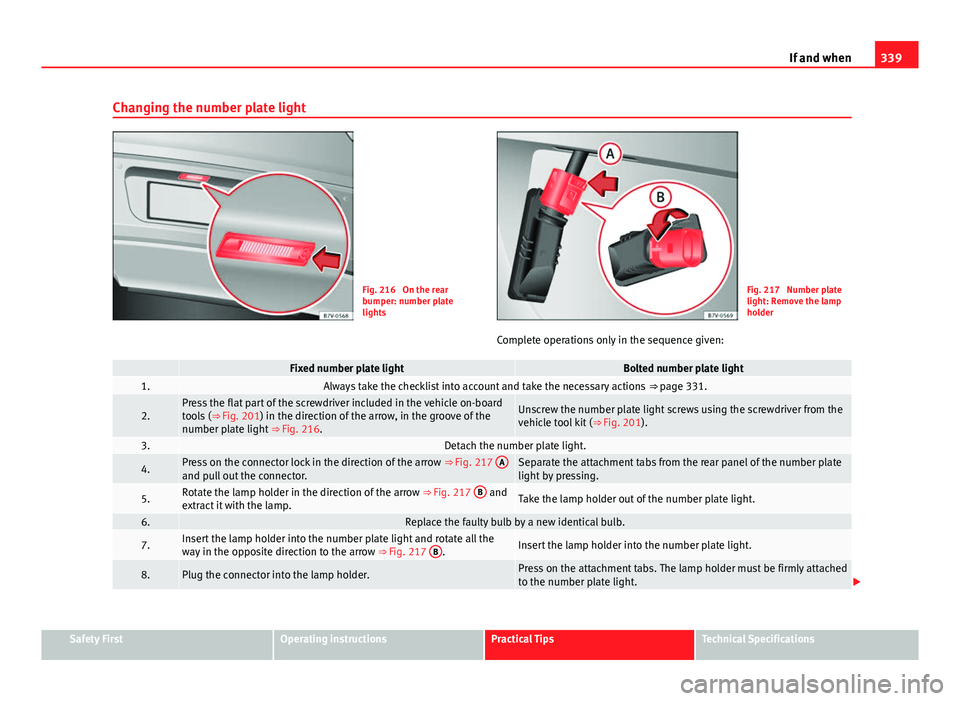
339
If and when
Changing the number plate light
Fig. 216 On the rear
bumper: number plate
lightsFig. 217 Number plate
light: Remove the lamp
holder
Complete operations only in the sequence given:
Fixed number plate lightBolted number plate light1.Always take the checklist into account and take the necessary actions ⇒ page 331.
2.Press the flat part of the screwdriver included in the vehicle on-board
tools (⇒ Fig. 201) in the direction of the arrow, in the groove of the
number plate light ⇒ Fig. 216.Unscrew the number plate light screws using the screwdriver from the
vehicle tool kit (⇒ Fig. 201).
3.Detach the number plate light.
4.Press on the connector lock in the direction of the arrow ⇒ Fig. 217 Aand pull out the connector.Separate the attachment tabs from the rear panel of the number plate
light by pressing.
5.Rotate the lamp holder in the direction of the arrow
⇒ Fig. 217 B and
extract it with the lamp.Take the lamp holder out of the number plate light.
6.Replace the faulty bulb by a new identical bulb.
7.Insert the lamp holder into the number plate light and rotate all the
way in the opposite direction to the arrow ⇒ Fig. 217 B.Insert the lamp holder into the number plate light.
8.Plug the connector into the lamp holder.Press on the attachment tabs. The lamp holder must be firmly attached
to the number plate light.
Safety FirstOperating instructionsPractical TipsTechnical Specifications
Page 342 of 381
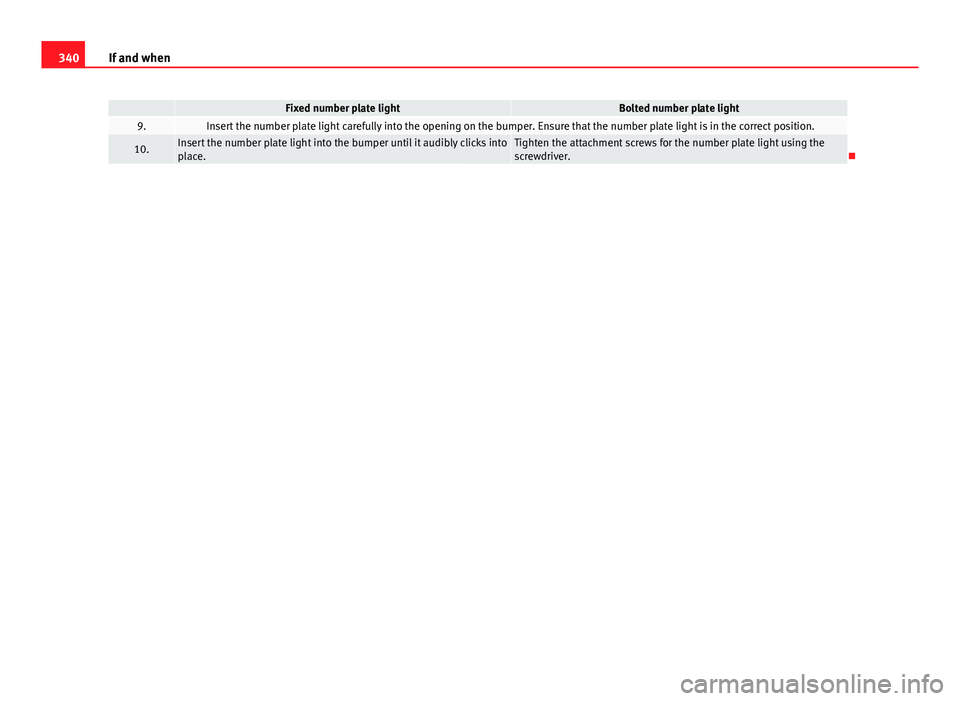
340If and when
Fixed number plate lightBolted number plate light9.Insert the number plate light carefully into the opening on the bumper. Ensure that the number plate light is in the correct position.
10.Insert the number plate light into the bumper until it audibly clicks into
place.Tighten the attachment screws for the number plate light using the
screwdriver.
Page 343 of 381
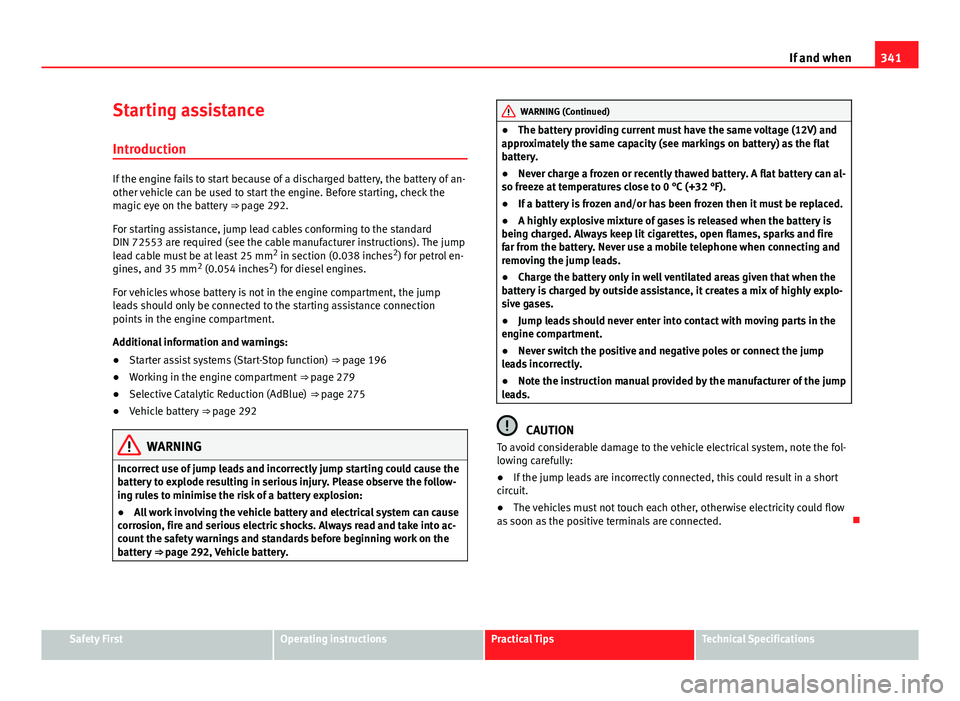
341
If and when
Starting assistance
Introduction
If the engine fails to start because of a discharged battery, the battery of an-
other vehicle can be used to start the engine. Before starting, check the
magic eye on the battery ⇒ page 292.
For starting assistance, jump lead cables conforming to the standard
DIN 72553 are required (see the cable manufacturer instructions). The jump
lead cable must be at least 25 mm 2
in section (0.038 inches 2
) for petrol en-
gines, and 35 mm 2
(0.054 inches 2
) for diesel engines.
For vehicles whose battery is not in the engine compartment, the jump
leads should only be connected to the starting assistance connection
points in the engine compartment.
Additional information and warnings:
● Starter assist systems (Start-Stop function) ⇒ page 196
● Working in the engine compartment ⇒ page 279
● Selective Catalytic Reduction (AdBlue) ⇒ page 275
● Vehicle battery ⇒ page 292
WARNING
Incorrect use of jump leads and incorrectly jump starting could cause the
battery to explode resulting in serious injury. Please observe the follow-
ing rules to minimise the risk of a battery explosion:
● All work involving the vehicle battery and electrical system can cause
corrosion, fire and serious electric shocks. Always read and take into ac-
count the safety warnings and standards before beginning work on the
battery ⇒ page 292, Vehicle battery.
WARNING (Continued)
● The battery providing current must have the same voltage (12V) and
approximately the same capacity (see markings on battery) as the flat
battery.
● Never charge a frozen or recently thawed battery. A flat battery can al-
so freeze at temperatures close to 0 °C (+32 °F).
● If a battery is frozen and/or has been frozen then it must be replaced.
● A highly explosive mixture of gases is released when the battery is
being charged. Always keep lit cigarettes, open flames, sparks and fire
far from the battery. Never use a mobile telephone when connecting and
removing the jump leads.
● Charge the battery only in well ventilated areas given that when the
battery is charged by outside assistance, it creates a mix of highly explo-
sive gases.
● Jump leads should never enter into contact with moving parts in the
engine compartment.
● Never switch the positive and negative poles or connect the jump
leads incorrectly.
● Note the instruction manual provided by the manufacturer of the jump
leads.
CAUTION
To avoid considerable damage to the vehicle electrical system, note the fol-
lowing carefully:
● If the jump leads are incorrectly connected, this could result in a short
circuit.
● The vehicles must not touch each other, otherwise electricity could flow
as soon as the positive terminals are connected.
Safety FirstOperating instructionsPractical TipsTechnical Specifications
Page 344 of 381
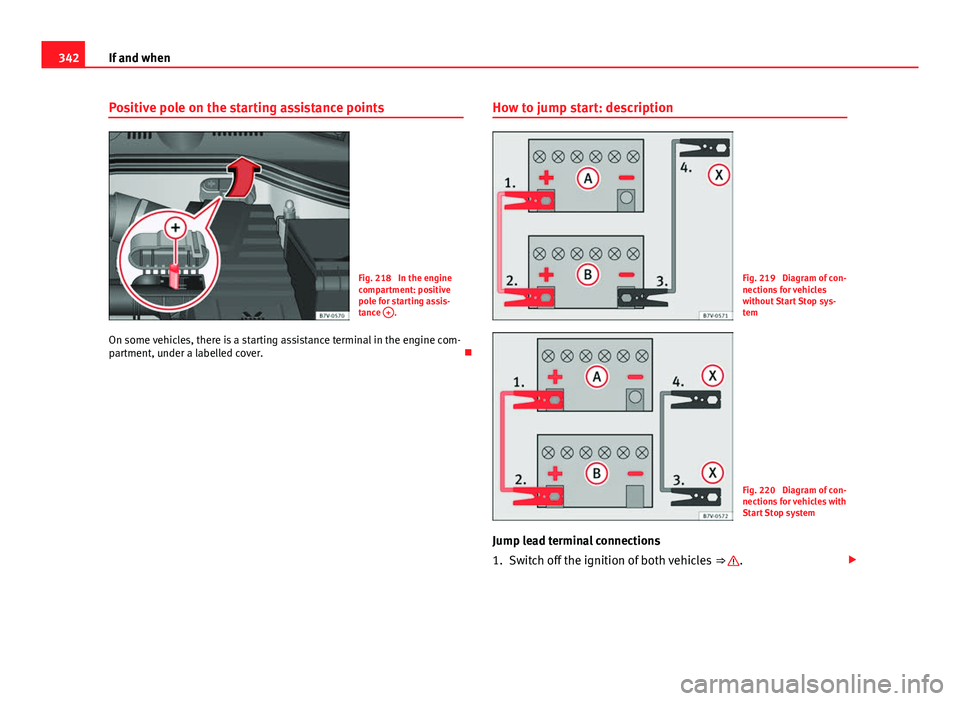
342If and when
Positive pole on the starting assistance points
Fig. 218 In the engine
compartment: positive
pole for starting assis-
tance +
.
On some vehicles, there is a starting assistance terminal in the engine com-
partment, under a labelled cover. How to jump start: description
Fig. 219 Diagram of con-
nections for vehicles
without Start Stop sys-
tem
Fig. 220 Diagram of con-
nections for vehicles with
Start Stop system
Jump lead terminal connections
1. Switch off the ignition of both vehicles ⇒
.
Page 345 of 381
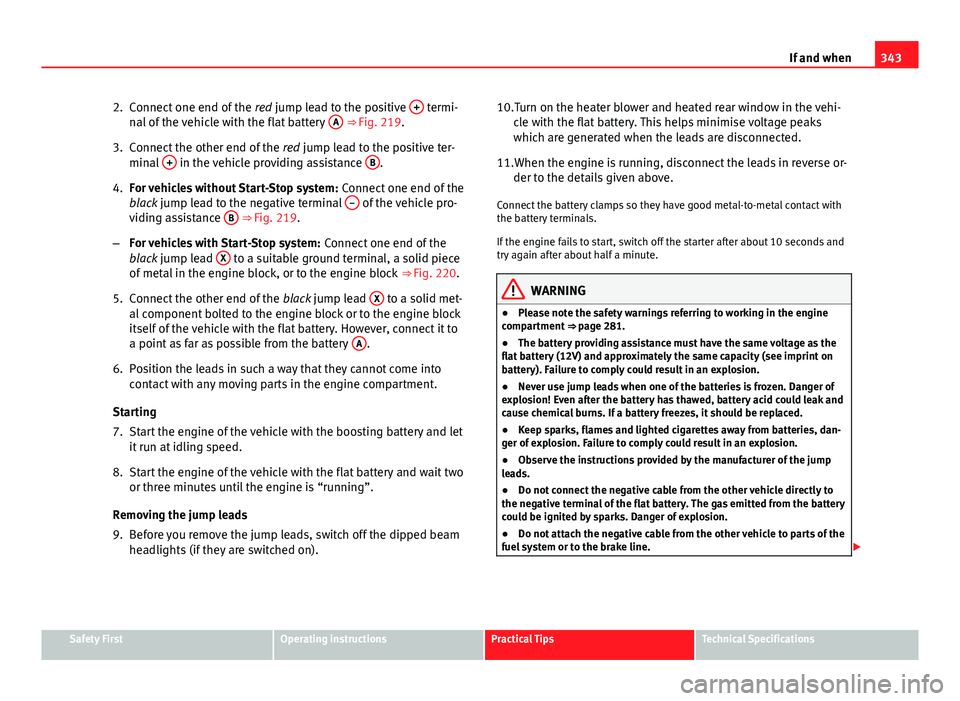
343
If and when
2. Connect one end of the red jump lead to the positive +
termi-
nal of the vehicle with the flat battery A ⇒ Fig. 219.
3. Connect the other end of the red jump lead to the positive ter-
minal +
in the vehicle providing assistance B.
4. For vehicles without Start-Stop system: Connect one end of the
black jump lead to the negative terminal –
of the vehicle pro-
viding assistance B ⇒ Fig. 219.
– For vehicles with Start-Stop system: Connect one end of the
black jump lead X
to a suitable ground terminal, a solid piece
of metal in the engine block, or to the engine block ⇒ Fig. 220.
5. Connect the other end of the black jump lead X
to a solid met-
al component bolted to the engine block or to the engine block
itself of the vehicle with the flat battery. However, connect it to
a point as far as possible from the battery A
.
6. Position the leads in such a way that they cannot come into contact with any moving parts in the engine compartment.
Starting
7. Start the engine of the vehicle with the boosting battery and let it run at idling speed.
8. Start the engine of the vehicle with the flat battery and wait two or three minutes until the engine is “running”.
Removing the jump leads
9. Before you remove the jump leads, switch off the dipped beam headlights (if they are switched on). 10.Turn on the heater blower and heated rear window in the vehi-
cle with the flat battery. This helps minimise voltage peaks
which are generated when the leads are disconnected.
11.When the engine is running, disconnect the leads in reverse or- der to the details given above.
Connect the battery clamps so they have good metal-to-metal contact with
the battery terminals.
If the engine fails to start, switch off the starter after about 10 seconds and
try again after about half a minute.
WARNING
● Please note the safety warnings referring to working in the engine
compartment ⇒ page 281.
● The battery providing assistance must have the same voltage as the
flat battery (12V) and approximately the same capacity (see imprint on
battery). Failure to comply could result in an explosion.
● Never use jump leads when one of the batteries is frozen. Danger of
explosion! Even after the battery has thawed, battery acid could leak and
cause chemical burns. If a battery freezes, it should be replaced.
● Keep sparks, flames and lighted cigarettes away from batteries, dan-
ger of explosion. Failure to comply could result in an explosion.
● Observe the instructions provided by the manufacturer of the jump
leads.
● Do not connect the negative cable from the other vehicle directly to
the negative terminal of the flat battery. The gas emitted from the battery
could be ignited by sparks. Danger of explosion.
● Do not attach the negative cable from the other vehicle to parts of the
fuel system or to the brake line.
Safety FirstOperating instructionsPractical TipsTechnical Specifications
Page 346 of 381
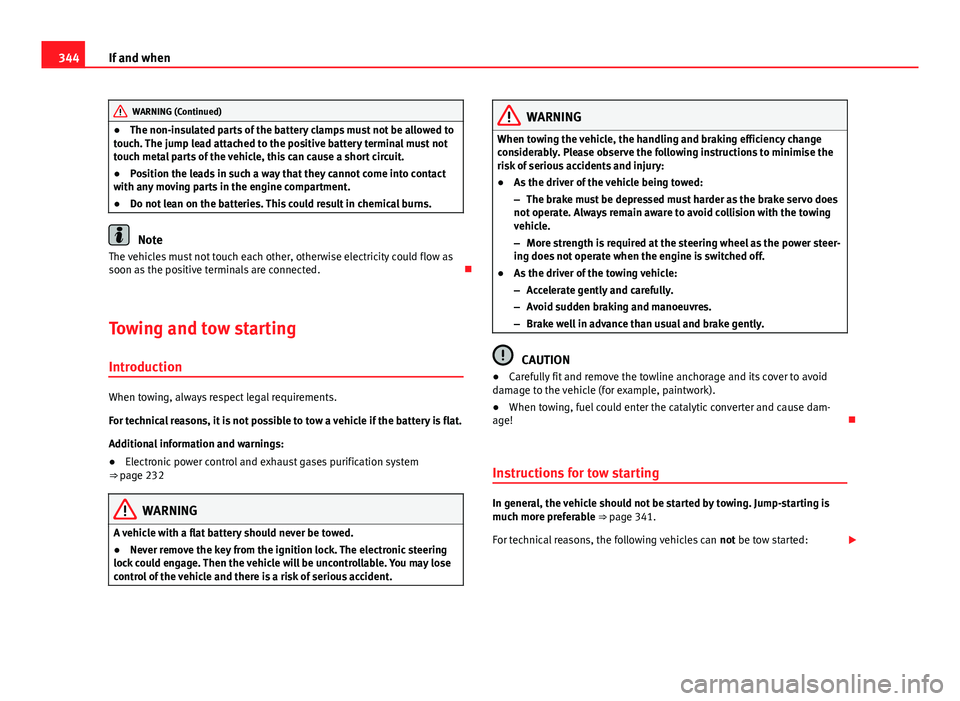
344If and when
WARNING (Continued)
● The non-insulated parts of the battery clamps must not be allowed to
touch. The jump lead attached to the positive battery terminal must not
touch metal parts of the vehicle, this can cause a short circuit.
● Position the leads in such a way that they cannot come into contact
with any moving parts in the engine compartment.
● Do not lean on the batteries. This could result in chemical burns.
Note
The vehicles must not touch each other, otherwise electricity could flow as
soon as the positive terminals are connected.
Towing and tow starting Introduction
When towing, always respect legal requirements.
For technical reasons, it is not possible to tow a vehicle if the battery is flat.
Additional information and warnings:
● Electronic power control and exhaust gases purification system
⇒ page 232
WARNING
A vehicle with a flat battery should never be towed.
● Never remove the key from the ignition lock. The electronic steering
lock could engage. Then the vehicle will be uncontrollable. You may lose
control of the vehicle and there is a risk of serious accident.
WARNING
When towing the vehicle, the handling and braking efficiency change
considerably. Please observe the following instructions to minimise the
risk of serious accidents and injury:
● As the driver of the vehicle being towed:
– The brake must be depressed must harder as the brake servo does
not operate. Always remain aware to avoid collision with the towing
vehicle.
– More strength is required at the steering wheel as the power steer-
ing does not operate when the engine is switched off.
● As the driver of the towing vehicle:
– Accelerate gently and carefully.
– Avoid sudden braking and manoeuvres.
– Brake well in advance than usual and brake gently.
CAUTION
● Carefully fit and remove the towline anchorage and its cover to avoid
damage to the vehicle (for example, paintwork).
● When towing, fuel could enter the catalytic converter and cause dam-
age!
Instructions for tow starting
In general, the vehicle should not be started by towing. Jump-starting is
much more preferable ⇒ page 341.
For technical reasons, the following vehicles can not be tow started:
Page 347 of 381
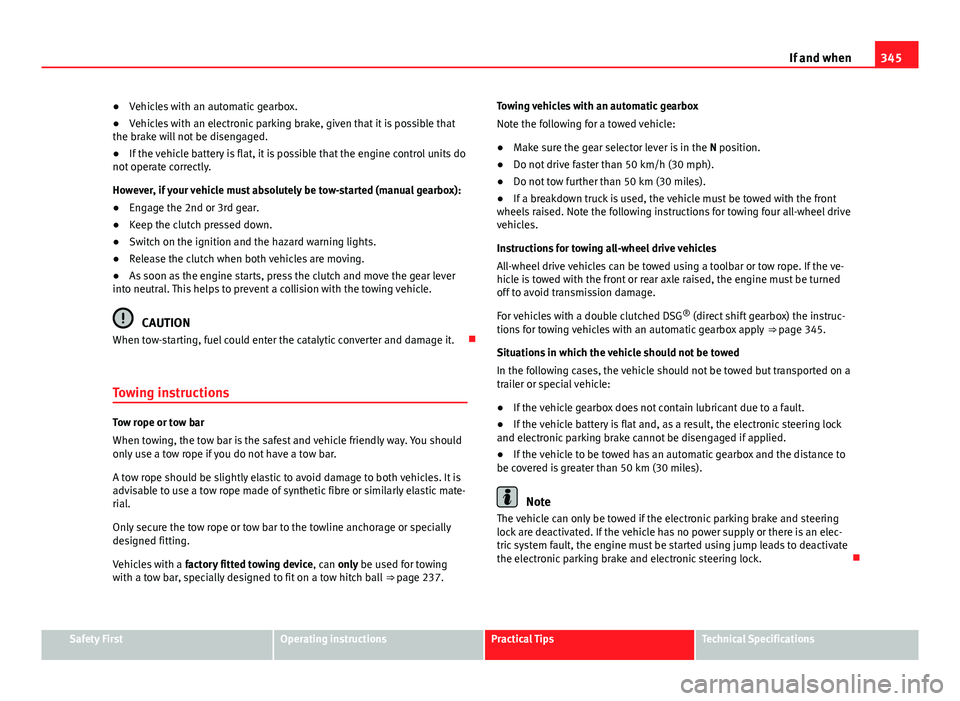
345
If and when
● Vehicles with an automatic gearbox.
● Vehicles with an electronic parking brake, given that it is possible that
the brake will not be disengaged.
● If the vehicle battery is flat, it is possible that the engine control units do
not operate correctly.
However, if your vehicle must absolutely be tow-started (manual gearbox):
● Engage the 2nd or 3rd gear.
● Keep the clutch pressed down.
● Switch on the ignition and the hazard warning lights.
● Release the clutch when both vehicles are moving.
● As soon as the engine starts, press the clutch and move the gear lever
into neutral. This helps to prevent a collision with the towing vehicle.
CAUTION
When tow-starting, fuel could enter the catalytic converter and damage it.
Towing instructions
Tow rope or tow bar
When towing, the tow bar is the safest and vehicle friendly way. You should
only use a tow rope if you do not have a tow bar.
A tow rope should be slightly elastic to avoid damage to both vehicles. It is
advisable to use a tow rope made of synthetic fibre or similarly elastic mate-
rial.
Only secure the tow rope or tow bar to the towline anchorage or specially
designed fitting.
Vehicles with a factory fitted towing device , can only be used for towing
with a tow bar, specially designed to fit on a tow hitch ball ⇒ page 237.Towing vehicles with an automatic gearbox
Note the following for a towed vehicle:
●
Make sure the gear selector lever is in the N position.
● Do not drive faster than 50 km/h (30 mph).
● Do not tow further than 50 km (30 miles).
● If a breakdown truck is used, the vehicle must be towed with the front
wheels raised. Note the following instructions for towing four all-wheel drive
vehicles.
Instructions for towing all-wheel drive vehicles
All-wheel drive vehicles can be towed using a toolbar or tow rope. If the ve-
hicle is towed with the front or rear axle raised, the engine must be turned
off to avoid transmission damage.
For vehicles with a double clutched DSG ®
(direct shift gearbox) the instruc-
tions for towing vehicles with an automatic gearbox apply ⇒ page 345.
Situations in which the vehicle should not be towed
In the following cases, the vehicle should not be towed but transported on a
trailer or special vehicle:
● If the vehicle gearbox does not contain lubricant due to a fault.
● If the vehicle battery is flat and, as a result, the electronic steering lock
and electronic parking brake cannot be disengaged if applied.
● If the vehicle to be towed has an automatic gearbox and the distance to
be covered is greater than 50 km (30 miles).
Note
The vehicle can only be towed if the electronic parking brake and steering
lock are deactivated. If the vehicle has no power supply or there is an elec-
tric system fault, the engine must be started using jump leads to deactivate
the electronic parking brake and electronic steering lock.
Safety FirstOperating instructionsPractical TipsTechnical Specifications
Page 348 of 381
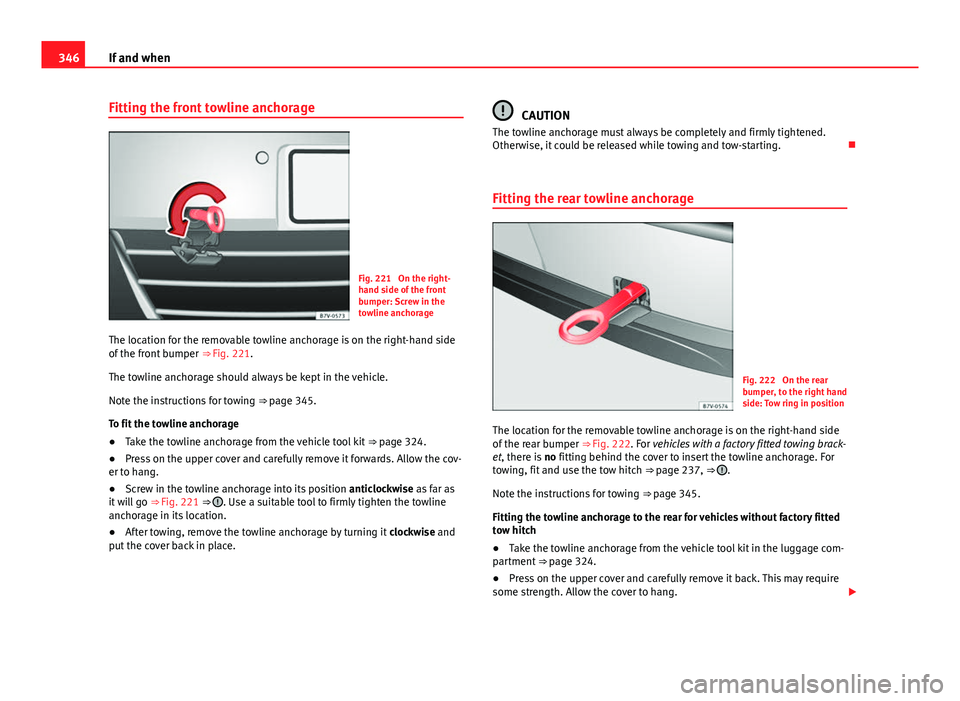
346If and when
Fitting the front towline anchorage
Fig. 221 On the right-
hand side of the front
bumper: Screw in the
towline anchorage
The location for the removable towline anchorage is on the right-hand side
of the front bumper ⇒ Fig. 221.
The towline anchorage should always be kept in the vehicle.
Note the instructions for towing ⇒ page 345.
To fit the towline anchorage
● Take the towline anchorage from the vehicle tool kit ⇒ page 324.
● Press on the upper cover and carefully remove it forwards. Allow the cov-
er to hang.
● Screw in the towline anchorage into its position anticlockwise as far as
it will go ⇒ Fig. 221 ⇒
. Use a suitable tool to firmly tighten the towline
anchorage in its location.
● After towing, remove the towline anchorage by turning it clockwise and
put the cover back in place.
CAUTION
The towline anchorage must always be completely and firmly tightened.
Otherwise, it could be released while towing and tow-starting.
Fitting the rear towline anchorage
Fig. 222 On the rear
bumper, to the right hand
side: Tow ring in position
The location for the removable towline anchorage is on the right-hand side
of the rear bumper ⇒ Fig. 222. For vehicles with a factory fitted towing brack-
et, there is no fitting behind the cover to insert the towline anchorage. For
towing, fit and use the tow hitch ⇒ page 237, ⇒
.
Note the instructions for towing ⇒ page 345.
Fitting the towline anchorage to the rear for vehicles without factory fitted
tow hitch
● Take the towline anchorage from the vehicle tool kit in the luggage com-
partment ⇒ page 324.
● Press on the upper cover and carefully remove it back. This may require
some strength. Allow the cover to hang.
Page 349 of 381
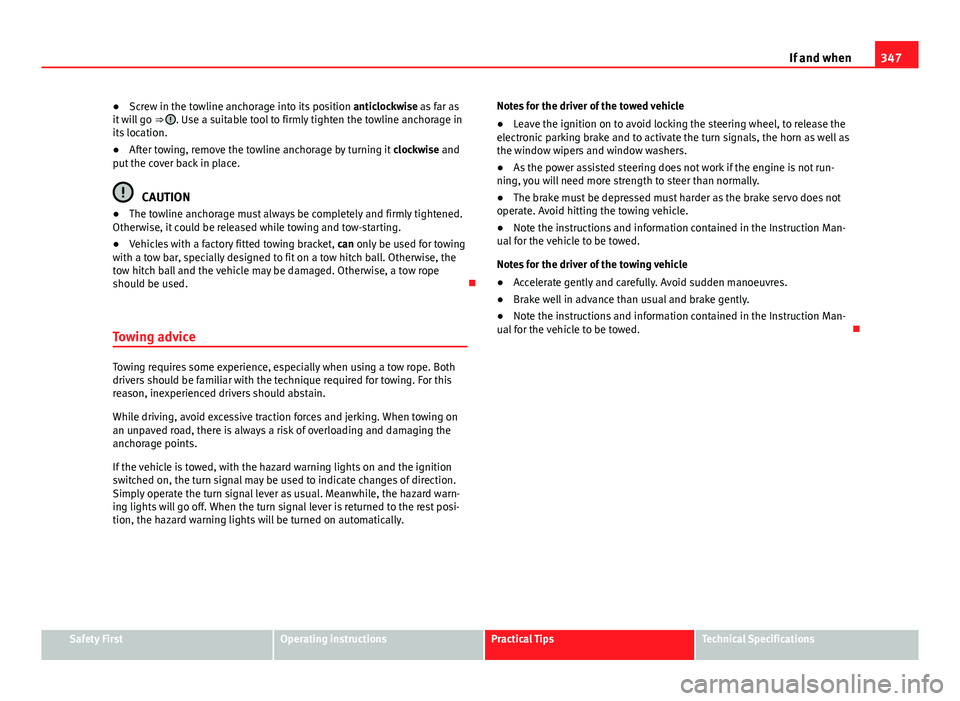
347
If and when
● Screw in the towline anchorage into its position anticlockwise as far as
it will go ⇒
. Use a suitable tool to firmly tighten the towline anchorage in
its location.
● After towing, remove the towline anchorage by turning it clockwise and
put the cover back in place.
CAUTION
● The towline anchorage must always be completely and firmly tightened.
Otherwise, it could be released while towing and tow-starting.
● Vehicles with a factory fitted towing bracket, can only be used for towing
with a tow bar, specially designed to fit on a tow hitch ball. Otherwise, the
tow hitch ball and the vehicle may be damaged. Otherwise, a tow rope
should be used.
Towing advice
Towing requires some experience, especially when using a tow rope. Both
drivers should be familiar with the technique required for towing. For this
reason, inexperienced drivers should abstain.
While driving, avoid excessive traction forces and jerking. When towing on
an unpaved road, there is always a risk of overloading and damaging the
anchorage points.
If the vehicle is towed, with the hazard warning lights on and the ignition
switched on, the turn signal may be used to indicate changes of direction.
Simply operate the turn signal lever as usual. Meanwhile, the hazard warn-
ing lights will go off. When the turn signal lever is returned to the rest posi-
tion, the hazard warning lights will be turned on automatically. Notes for the driver of the towed vehicle
●
Leave the ignition on to avoid locking the steering wheel, to release the
electronic parking brake and to activate the turn signals, the horn as well as
the window wipers and window washers.
● As the power assisted steering does not work if the engine is not run-
ning, you will need more strength to steer than normally.
● The brake must be depressed must harder as the brake servo does not
operate. Avoid hitting the towing vehicle.
● Note the instructions and information contained in the Instruction Man-
ual for the vehicle to be towed.
Notes for the driver of the towing vehicle
● Accelerate gently and carefully. Avoid sudden manoeuvres.
● Brake well in advance than usual and brake gently.
● Note the instructions and information contained in the Instruction Man-
ual for the vehicle to be towed.
Safety FirstOperating instructionsPractical TipsTechnical Specifications
Page 350 of 381
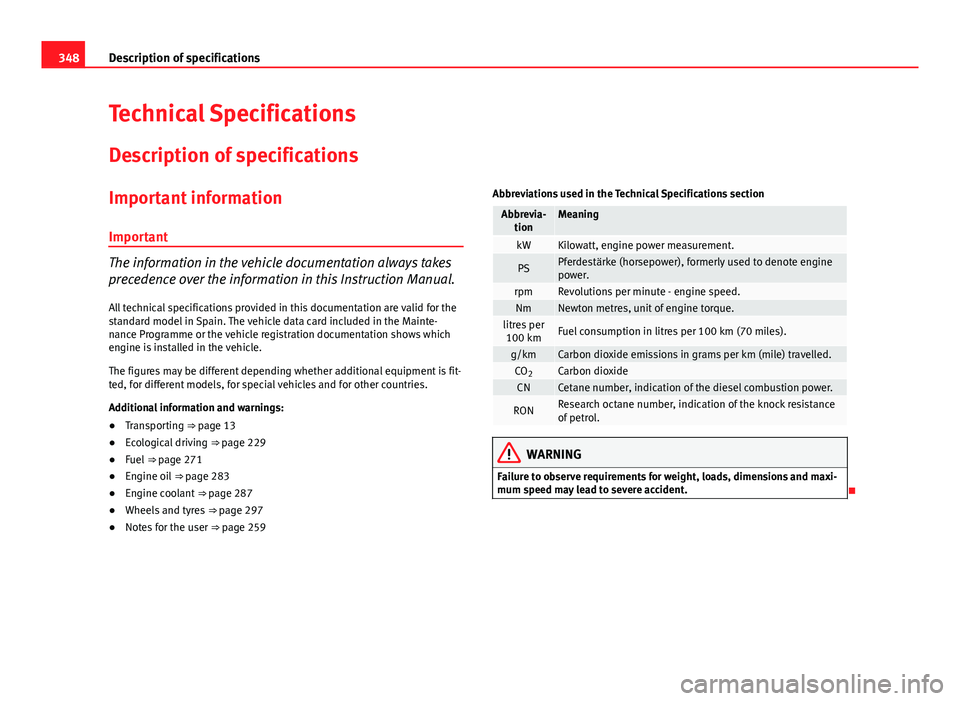
348Description of specifications
Technical Specifications
Description of specifications
Important information
Important
The information in the vehicle documentation always takes
precedence over the information in this Instruction Manual.
All technical specifications provided in this documentation are valid for the
standard model in Spain. The vehicle data card included in the Mainte-
nance Programme or the vehicle registration documentation shows which
engine is installed in the vehicle.
The figures may be different depending whether additional equipment is fit-
ted, for different models, for special vehicles and for other countries.
Additional information and warnings:
● Transporting ⇒ page 13
● Ecological driving ⇒ page 229
● Fuel ⇒ page 271
● Engine oil ⇒ page 283
● Engine coolant ⇒ page 287
● Wheels and tyres ⇒ page 297
● Notes for the user ⇒ page 259 Abbreviations used in the Technical Specifications section
Abbrevia-
tionMeaning
kWKilowatt, engine power measurement.
PSPferdestärke (horsepower), formerly used to denote engine
power.
rpmRevolutions per minute - engine speed.NmNewton metres, unit of engine torque.litres per100 kmFuel consumption in litres per 100 km (70 miles).
g/kmCarbon dioxide emissions in grams per km (mile) travelled.CO 2Carbon dioxideCNCetane number, indication of the diesel combustion power.
RONResearch octane number, indication of the knock resistance
of petrol.
WARNING
Failure to observe requirements for weight, loads, dimensions and maxi-
mum speed may lead to severe accident.